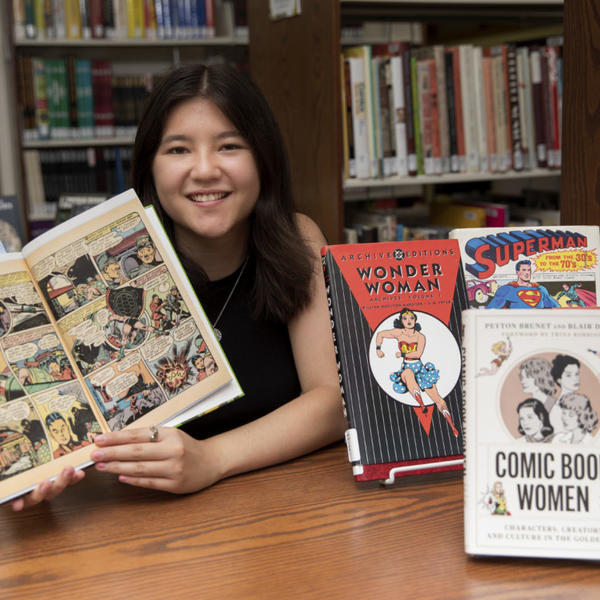Curious about how Chinese American identity was constructed and portrayed in comics during the 1940s and 1950s, Emma Grayeb ’24, an Asian studies and history double major, decided to dedicate her summer to researching the issue. As one of several Holy Cross students participating in the Charles S. Weiss Summer Research Program, Grayeb spent weeks dissecting three comics series published during this Golden Age of Comics (1938-1956), focusing on features including a Chinese American as a sidekick to a hero, as a hero, and as a hero and a villain.
Why did you decide to focus on Chinese American identity in the post WWII decades?
I decided to focus on Chinese American identity during the Second World War and early Cold War era because there were several significant shifts in the ways that Chinese Americans were depicted and perceived. During World War II, the United States and China were allies, which fostered a new acceptance for Chinese Americans. However, when relations began to falter with the rise of communism in China, this group of people was viewed with suspicion once again. Despite this, the United States aimed to represent itself to the world as the beacon of democracy, and so the acceptance of minority groups was encouraged. This created a complex and almost paradoxical environment where Chinese Americans were more widely accepted into the grand melting pot that was the ideal America, but Chinese people and culture were demonized, and seen as antithetical to what it meant to be American.
Why did you decide to use comics for your research?
Comic books are fascinating. A survey done by the Market Research Company of America found that “70,000,000 people, or just about half the U.S. population,” read comic books, according to the Nov. 23, 1945, issue of “Yank, The Army Weekly.” Not only that, but readership stretched across both age and sex, including a wide variety of people during this time. Comic books were consumed by the general American public and were also produced by them. Many creators came from working class immigrant backgrounds. Therefore, comic books were a highly influential aspect of popular culture that simultaneously reflected and affected American public thought, albeit in often veiled or exaggerated ways.
Do you intend to continue with this research after the summer? If so, how?
I have found researching the history of Chinese American identity to be incredibly rewarding and am grateful for this experience that was made possible through the Weiss Summer Research Program. Ke Ren, assistant professor of history and my advisor this summer, has taught me a lot about what it means to be a good historian and has shown me just how exciting research can be. I hope to continue to learn more about this topic throughout my academic career. Senior year, I would love to write a thesis that includes some elements from this project.
Chinese Americans Depicted as Hero, SideKick and Villain in Vintage WWII-Era Comics

Emma Grayeb ’24 analyzed how war propaganda and changing American sentiment affected how Chinese Americans were portrayed during the post-WWII era through the onset of the Cold War.
Read Time
2 Minutes

